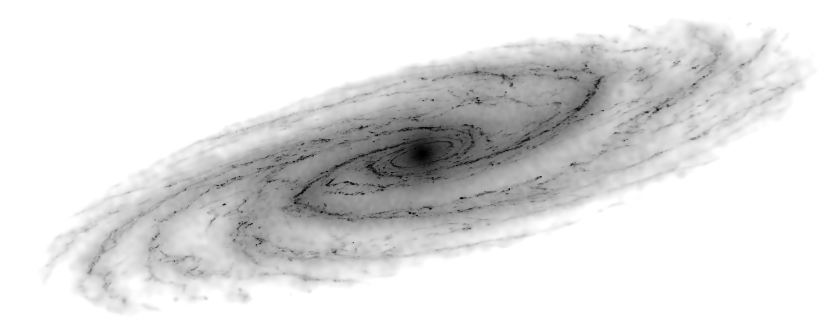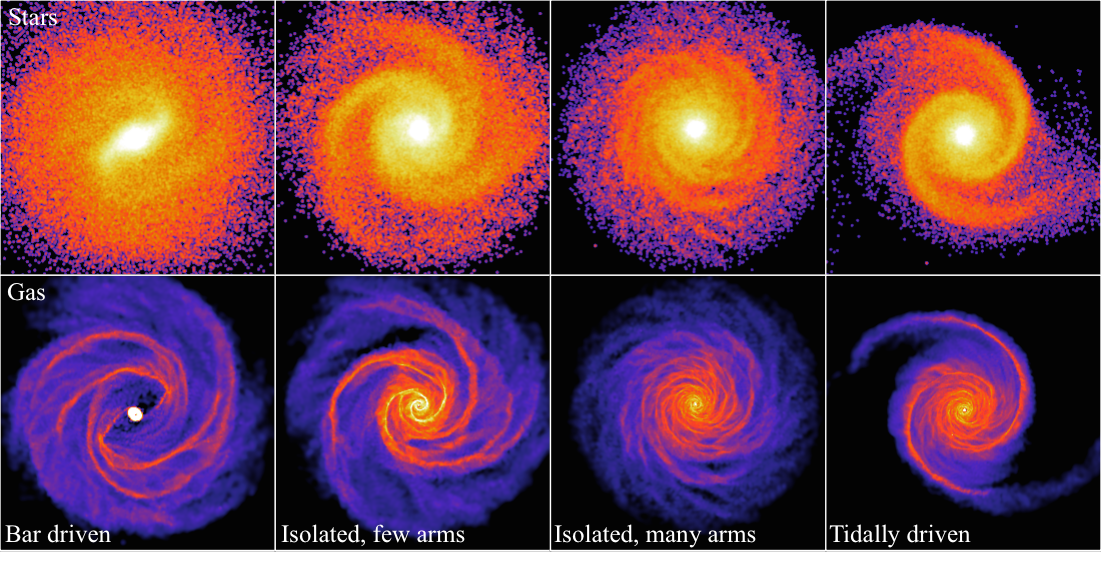


Galactic MorphologyThe reason galaxies look the way they do. |
Relevant papers: Salak et al. 2019, Dobbs et al. 2018, Pettitt & Wadsley 2018, Dobbs et al. 2016, Pettitt et al. 2016, Few et al. 2016.
Spiral arms in disc galaxies are seemingly commonplace. However, despite decades of research we do not truly understand what creates these majestic spiral arms, and what their relation is with other galactic structures, such as inner bars.
We know that galaxies exhibit flat rotation curves, that is they do not rotate about their centre as a solid object, but rather material usually moves at the same speed regardless of where you are in the galaxy. This constant rotation in galaxies means any pattern on the surface, such as spiral arms, would wind up over time. Whatever causes the spiral arms in galaxies must have some way of circumventing this “winding problem”.

Many theories exist that try to explain these observed arms (see the picture above for a taste). However, galactic physicists still a ways to go to really get to the bottom of this problem.

Some spiral galaxies exhibit long straight concentrations of stars and gas in their inner disc (e.g. galaxies such as NGC 1300 and NGC 1365). These bars can often be seen to have arms trailing from each in observed galaxies end, and theoretical work has shown they are very effective at driving arms in interstellar gas. Above are a few examples of some bars formed in simulations and a movie of the left-most simulation is shown below.
A more complicated theory of spiral structure is that the spirals we seen are more like waves of higher stellar density than in the rest of the disc, rather than fixed structures. Such spiral arms are akin to traffic jams, with cars (stars) flowing into and out of the jam (arm). This jam (arm) is visible as a high concentration of cars (stars) from far away, but the cars (stars) in the jam (arm) continually flow in and out. The image below shows how special kinds of orbital families can align in certain ways to produce spiral-like features.

This allows spiral patterns to be formed free of the winding problem. This is known as the spiral density wave theory of arm formation. Concrete evidence that this process underpins all spirals in nature, however, is still elusive. Below is a simulation of gas moving through such a spiral pattern, note how the gas can clearly be seen to move in and out of the arms, creating small scale inter-arm features.
Computer simulations of galaxies have been unable to generate these proposed standing spiral density waves. They do produce spirals, but they are appear quite different to what is expected. Such spirals are instead seen to rotate at a non-constant rate, and are instead transient and ever changing. These arms will fall victim to the winding problem, but structures simply reform in the wake of the destruction of the old ones.
The simulation below is one such example. On the left is the stellar material, and the right the gas. Notice how arms form and are sheared out, though there are new spiral arms being formed to replace them.
Another method of spiral formation is that of the gravitational force of nearby body perturbing a galactic disc. The tidal forces caused by the passage of a smaller companion can easily induce 2-armed spirals (such as that seen in M51). The image below shows a series of snapshots of a simulation where a galaxy has experienced an interaction (time increases to the right) creating a 2-armed spiral structure.

This mechanism is clearly the reason behind some spiral features, but of course is not the case for isolated galaxies. The preference this mechanism creating solely 2-armed structures also calls for some other mechanism to explain the 4-armed spirals seen in the night sky.